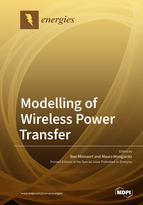Modelling of Wireless Power Transfer
A special issue of Energies (ISSN 1996-1073). This special issue belongs to the section "A1: Smart Grids and Microgrids".
Deadline for manuscript submissions: closed (15 October 2020) | Viewed by 22629
Special Issue Editors
Interests: wireless power transfer; energy harvesting; energy efficiency; embedded systems; wireless sensor networks and IoT-applications
Special Issues, Collections and Topics in MDPI journals
Interests: microwave; antennas; guided waves; CAD; wireless power transfer
Special Issues, Collections and Topics in MDPI journals
Special Issue Information
Dear Colleagues,
Technically, any device that needs power can become an application for wireless power transfer (WPT). The current list of applications in which WPT is applied is therefore very diverse, from low-power portable electronics and household devices to high-power industrial automation and electric vehicles. With the rise of IoT sensor networks and industry 4.0, the presence of WPT will only increase.
In order to improve the current state of the art, models are being developed and tested experimentally. Such models represent either part of the WPT technology (e.g., the wireless link itself) or are focused on a certain application (e.g., transcutaneous energy transfer). They allow simulating, quantifying, predicting, or visualizing certain aspects of the power transfer from transmitter(s) to receiver(s). Moreover, they often result in a better understanding of the fundamentals of the wireless link.
This Special Issue, entitled “Modelling of Wireless Power Transfer” mainly covers original research related to the modelling of WPT, including academic and theoretical studies, as well as experimental work. It covers a broad range of models, from conceptual and graphical models to mathematical and numerical models. Potential topics include, but are not limited to, the following:
- Near-field WPT;
- Inductive coupling;
- Capacitive coupling;
- Far-field WPT;
- Microwave/RF WPT;
- Multiple transmitters and/or receivers;
- Optimizing working conditions;
- Frequency control;
- Optimizing power transfer/efficiency/gains;
- Components design;
- Electronics design.
Dr. Ben Minnaert
Prof. Dr. Mauro Mongiardo
Guest Editors
Manuscript Submission Information
Manuscripts should be submitted online at www.mdpi.com by registering and logging in to this website. Once you are registered, click here to go to the submission form. Manuscripts can be submitted until the deadline. All submissions that pass pre-check are peer-reviewed. Accepted papers will be published continuously in the journal (as soon as accepted) and will be listed together on the special issue website. Research articles, review articles as well as short communications are invited. For planned papers, a title and short abstract (about 100 words) can be sent to the Editorial Office for announcement on this website.
Submitted manuscripts should not have been published previously, nor be under consideration for publication elsewhere (except conference proceedings papers). All manuscripts are thoroughly refereed through a single-blind peer-review process. A guide for authors and other relevant information for submission of manuscripts is available on the Instructions for Authors page. Energies is an international peer-reviewed open access semimonthly journal published by MDPI.
Please visit the Instructions for Authors page before submitting a manuscript. The Article Processing Charge (APC) for publication in this open access journal is 2600 CHF (Swiss Francs). Submitted papers should be well formatted and use good English. Authors may use MDPI's English editing service prior to publication or during author revisions.
Keywords
- wireless power transfer
- inductive power transfer
- capacitive power transfer
- microwave/RF wireless power transfer
- magnetic resonance
- modelling
- simulations
- electric vehicles
- IoT
- wireless sensor networks
- medical implants
- electronics design
- components design
- energy harvesting.







